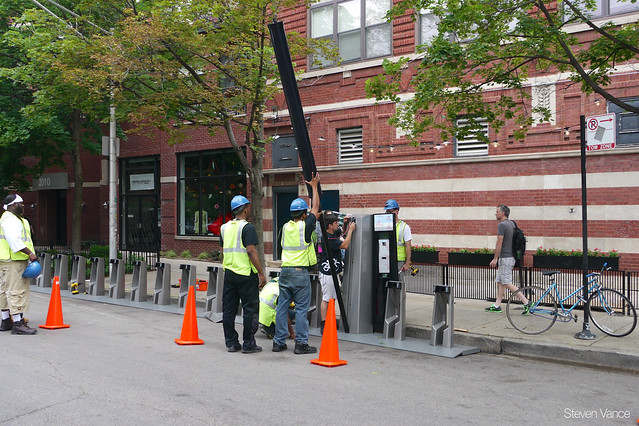
The December meeting of the Mayor's Bicycle Advisory Committee included lots of news about the future of the Divvy program. Ever since the bike-share program launched on June 28, 2013, 3.1 million users, including 23,177 annual members and many daily users, have biked over 6.6 million miles starting at 300 stations.
A previously planned expansion will bring the system to 475 stations, 4750 bikes and 31 wards. That will broaden the service area's edges to Touhy Avenue (7200 North) to 75th Street (7500 South), from the lake to as far west as Pulaski (4000 West). State grant money has been allocated for an additional 50 stations, further extending Divvy north through Rogers Park into Evanston, and west through Garfield Park and Austin into Oak Park.
A new member survey will be going out soon. Last winter’s survey showed a disappointing lack of diversity among annual members, who were 65 percent male, 79 percent white, 93 percent college educated, and averaged 34 years old. Divvy hopes that a larger coverage area, continued outreach, and efforts to increase access for the unbanked will improve diversity among both annual members and daily users.
Divvy has launched an equity initiative that applies to station siting, public outreach, hiring, and youth training. In the first two years, station siting prioritized locations with perceived high demand. The priority now is being shifted to create a higher density network of stations throughout the Divvy service area, so that lower density neighborhoods of color (where current stations are sometimes a mile apart) will be better served. The goal for both infill and expansion of the service area is for stations to be no more than half a mile apart, putting Divvy within a five minute walk of everyone within the service area.
Outreach to community leaders is planned, which will help build community connections to the program. This could be through neighborhood organizations and programs, as well as citywide efforts such as Red Bike & Green or Slow Roll.
A Design a Divvy contest will be aimed at neighborhoods where Divvy will be introduced in 2015. The contest would seek neighborhood-specific graphic designs for bikes in areas getting new service, raising awareness of Divvy and helping to build community interest.
On the employment side, Divvy will continue employment diversity and youth training partnerships with three programs: GreenCorps for adults and youth, and Skills for Chicagoland’s Future. GreenCorps' youth program helps students ages 16 to 19 in neighborhoods with a high risk of violence. The adult programs work with people facing barriers to employment.
Divvy for Everyone (D4E) is a new program being developed to study ways to increase Divvy's availability to the unbanked. Since the majority of CTA users are now using Ventra for fare payment, its debit-card function could provide a viable way for daily users to access the system, although the card's high fees may be a concern. Ventra and Divvy keys are based on similar technology, so it's also possible that a Ventra card could eventually substitute for a key.
Thoughtful questions were raised at the meeting in relation to Divvy and Streets for Cycling 2020. For instance, gaps in the bike route network, and poorly maintained bikeways, might affect use of both Divvy and personal bikes in black communities, and it might prove difficult to effectively promote bicycling as transportation in communities that lack a solid network of rideable routes. Divvy could also try to analyze credit card data from daily users to get a sense of how their demographics may differ from annual members.
The 2015 expansion of Divvy, and new partnerships with neighborhood leaders, organizations and programs, have the potential to make Divvy an accessible, practical form of transportation for a wider range of Chicago’s population and neighborhoods.




